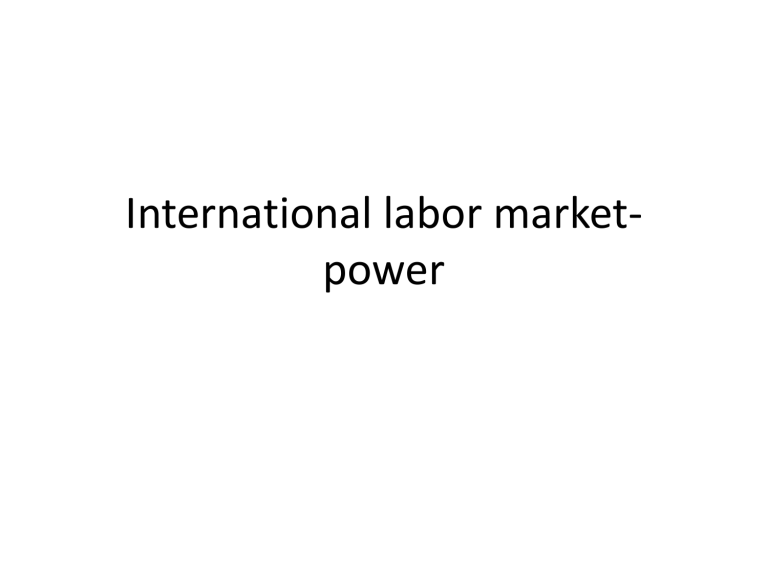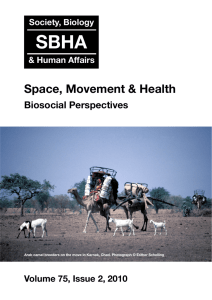International labor market

International labor marketpower
Plan
•
Notion of the international labor market and its types
•
Features and consequences of LM
•
Export and import of labor force
• “labor mobility” in macroeconomics
•
Mobility of labor isn't associated with migration.
•
Globalization aspects of labor mobility
•
Export of Labor force from Tajikistan
Introduction
• International labor market - a form of existence of labor migration. It is not simply the sum of national markets, and represents a new qualitative development of the labor market in the face of increasing internationalization of production and the growth of dialogue between peoples. National labor markets are increasingly losing their insularity and isolation. Between them there are transnational flows and movement of labor, which acquire a permanent and systematic.
Concept
• Mass migration has become one of the characteristic phenomena of the world community to the second half of the twentieth century. International (external) migration exists in different forms: work, family, recreation, tourism, etc.
Consequences of LM
• Researching the potential of international migration frames the researchers came to the conclusion that they are represented generally younger, professionally trained, economically active, but socially disadvantaged workers. This conclusion is also confirmed by foreign sources. So, J. Borges notes that foreign workers in the U.S., for example, at the beginning of getting less than the Native
Americans, but in 10-15 years, begin to earn more, largely due to
"natural selection" foreign workers in their composition are the most capable and motivated people.
• Consideration of the positive and negative effects of international labor migration is the basis for determining the directions of state and regional policies and building a system of regulation of this process, providing for the establishment of certain social institutions and structures that govern international migration at various levels
Countr ies-exporter labor force
Positive
1. Acquisition of employees with new qualifications
2. Refusing deficit of balance of payment
3. Potential weakening in internal labor market
Negative
1. Losing qualification of labor force
2. Consolidation of relation from foreign demand not only for goods and labor force too.
3. Reorientation of capital investment with the introduction of manufactured resources in consumption.
4. Structural alleviation and technological rearrangement of production
4. Inflation growth
1. Alleviation of structures in regional displacement
2. Vertical promotion mobility of local employers
Countr iesimporter labor force
3. Reducing cost of labor force, general cost, associate with the strength reducing of labor force
4. Inhibition of growing price, due to hang of foreign employees to savings.
1. Block the introduction of labor-saving technologies
2. Involve the situation in internal market of labor force
3. Rising of costs in the meaning of unemployed foreigners and their family
5. Increasing quality of labor force with way of picking younger and qualified employees.
X & M of Labor Force
• Asymmetry of labor markets at the macro-and mega-level structural deformation caused by economies of depressed regions, actualizes the problem feasibility professional diverse workforce and encourage the growth of its mobility within the intensification of world integration processes and the formation of institutions of international labor mediation.
• Imbalance in meeting the needs of the national (regional and municipal) foreign labor economy to a large extent part of unsufficient single methodologically conceptual approach to internationalization recruiting processes derived from being in the moment in the making of the international labor market (MRI).
• In recent years, more attention is paid to the problem of a universal legal structure, which is impossible to determine a single system of legal export-import labor (alternative regional and municipal unemployment
Mobility
• Mobility - the ability to move, movement. In economics, the term mobility applies to all resources and these resources means the ability to change the place of application. Mobility has similarities with the liquidity of money: as well as liquidity, mobility quantitatively expressed in costs (associated with changes in application resource).
• Mobility of resources are of great importance in the economy (the country and the world). Freedom of movement of resources is an integral part of perfect competition (from which, however, there is little that is left), as an optimal allocation of resources, which means the production of those goods in which society needs most.
Mobility is not associated with migration
• This special kind of labor mobility, which involves the use of advanced telecommunications technologies and software.
• The scheme works as follows: the employer communicates with employees through the Internet gives it a certain job, and then it gets executed via the Internet. Of course, there are certain limitations to such mobility: it is impossible, for example, so hire a builder (referring to the builder, who lives in another hemisphere, for example).
• This type of migration is often called out-sourcing (outsourcing), this term is entered into the Russian language.
This type of migration is currently being applied for the order from the foreign language translation, software development (particularly successful in India, but also in
Russia and there are precedents).
Globalization aspects
• So, by the end of the twentieth century, due to international migration, the traditional centers of attraction of migrants USA, Canada and Australia added new global labor markets. These are the countries of Western Europe, Asia-Pacific,
Middle East oil-producing countries, Argentina and Venezuela in Latin America, as well as the richest African States.
• According to estimates from 1950 to 1990, the U.S. took 25 million immigrants from Latin America, Southeast Asia and other regions, Germany - 9 million, France
- 4 million, and Canada and Australia - 3.5 million people. The number of immigrants in the 7 richest oil producing countries (Saudi Arabia, Libya, UAE,
Kuwait, Oman, Qatar and Bahrain) has increased in the period from 1975 to 1990, from 1.9 million to 8 million people.
• A characteristic feature of contemporary migration is that it flows consist of two directions, and hence the same state can be both donor and recipient country.
• For example, the United Kingdom and the United States are both among the top recipient countries in the world, and donors for individual states (U.S. donor for
Canada, United Kingdom - for Australia).
Forecast
• In 2009-2011, the international labor market, due to increased competition, introduction of modern production equipment, high technology, international quality requirements, unemployment will take place, and at the same time - and a substantial increase in the deficit of skilled workers, especially in industry, agriculture, services sector and others that require a major effort to ensure the required quality level workers, training and retraining of workers and specialists, the implementation of efficient management, organization and motivation.
Forecast cont.
• Currently in the world there are 160,000,000 of officially registered unemployed. These data are presented in the Director General of the
International Labor Organization (ILO) Juan
Somavia. However, given the hidden unemployment, the number will increase to at least 1 billion. A projected economic growth in
2009 will not lead to an adequate increase in the number of working people as input jobs will replace part of the workers who were forced busy now part-time job.
Export of Labor force from TJ
• Export of labor is accompanied by currency translations immigrants, acting as a kind of payment for exported goods - human resources. Moreover, obtaining foreign exchange earnings from the export of labor does not lead to the simultaneous production costs in the country of origin, as is typical for trade.
There are four direct source of foreign exchange earnings from the export of labor
• income taxes intermediary firms;
• direct translation immigrants home to support families and relatives;
• private investment immigrants (bringing home the means of production and consumer durables, the purchase of land, real estate, purchase of securities, etc.).
• capital from countries - importing labor, often going on the reproduction of the labor force and in the social sphere.
• In addition, the possible direct compensation for leakage from the labor importing countries.






